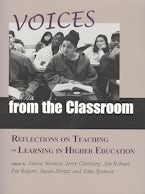Introduction: Responsibility, Respect, Research and Reflection in Higher Education
SECTION I: POWER, DIVERSITY AND EQUITY IN THE CLASSROOM
Introduction
Part One: Student Voices
1. Gender, Power and Silence in the Classroom: Our Experiences Speak for Themselves
2. Fog and Frustration: The Graduate Student Experience
3. 'Dissertation Dementia': Reflections on One Woman's Graduate Experience
Part Two: Teachers' Voices
1. Power in the Classroom
2. The University Classroom: From Laboratory to Liberatory Education
3. Diversity in the Classroom: Engagement and Resistance
4. Responsibility and Respect in Critical Pedagogy
5. Feminist Pedagogy: Paradoxes in Theory and Practice
6. Teaching 'Women and Men in Organizations': Feminist Pedagogy in the Business School
7. Empowering Students Through Feminist Pedagogy
8. Heterosexism in the Classroom
9. DisABILITY in the Classroom: The Forgotten Dimension of Diversity?
10. Teaching Students with Learning Disabilities
11. Avoiding the Retrofitted Classroom: Strategies for Teaching Students with Disabilities
12. Adult Students
13. English-as-a-Second-Language Students
SECTION II: THEORIES AND MODELS OF STUDENT LEARNING
Introduction
1. Teaching Styles/Learning Styles: The Myers Briggs Model
2. The Gregorc Model of Learning Styles
3. Student Development: From Problem-Solving to Problem-Finding
4. Using Theories about Student Learning to Improve Teaching
SECTION III: COURSE DESIGN
Introduction
1. Course Planning: From Design to Active Classroom
2. Developing and Teaching a Science Course: A Junior Faculty Member's Perspective
3. The Dialectic of Course Development: I Theorize, They React... and Then?
4. Beyond Bare Facts: Teaching Goals in Science
5. 'Why Didn't He Just Say It?': Getting Students Interested in Language
SECTION IV: WORKING WITH GRADUATE STUDENTS
Introduction
1. Graduate Supervisory Practices
2. Working Together: The Teaching Assistant-Professor Relationship
3. Working with Teaching Assistants
4. Issues for International Teaching Assistants
SECTION V: ACADEMIC HONESTY
Introduction
1. Academic Dishonesty
2. Plagiarism and Student Acculturation: Strangers in the Strange Lands of our Disciplines
3. Plagiarism and the Challenge of Essay Writing: Learning from our Students
4. Honesty in the Laboratory
5. Electronic Plagiarism: A Cautionary Tale
SECTION VI: TEACHING AND LEARNING STRATEGIES
Introduction
Part One: Lecturing
- Effective Lecturing Techniques
- Improving Large-Class Lecturing
- Improving Student Learning in Lectures
Part Two: Class Participation
- Dead Silence... A Teacher's Nightmare
- Evoking and Provoking Student Participation
- Resistance in the Classroom
- Computer-Mediated Communication: Some Thoughts about Extending the Classroom
Part Three: Seminars, Tutorials and Small-Group Learning
- Study Group Guide for Instructors and Teaching Assistants
- Warm-Ups: Lessening Student Anxiety in the First Class
- Small is Beautiful: Using Small Groups to Enhance Student Learning
- Integrating Group Work into our Classes
- Scrapbook Presentations: An Exercise in Collaborative Learning
- The Field Walk
- Teaching with Cases
- Stages in Group Dynamics
- The Joy of Seminars
- The Office Hour: Not Just Crisis Management
- Negotiating Power in the Classroom: The Example of Group Work
SECTION VII: ASSIGNMENTS AND EVALUATION
Introduction
Part One: Reading
- When No One Has Done the Reading
- A Strategy for Encouraging Students to do Readings
- Telling a Book by Its Cover
- The Sherlock Holmes Approach to Critical Reading (Or How to Help Students Become Good 'Detextives')
Part Two: Research Essays and Other Writing Assignments
- Sequencing Assignments
- An Experiment in Writing and Learning Groups
- Paper Chase: The Sequel
- Working with Students' Writing
- What Happens After You Say, 'Please Go to the Writing Centre?'
Part Three: Grading and Evaluation
- Evaluating Student Writing: Problems and Possibilities
- Fast, Fair and Constructive: Grading in the Mathematical Sciences
- An Individualized Approach to Teaching and Evaluation
- The Norwegian Motivator, or How I Make Grading Work for Me and My Students
SECTION VIII: DEVELOPING AND ASSESSING YOUR TEACHING
Introduction
Part One: Classroom Assessment
- Improving Student Learning Through Feedback: Classroom Assessment Techniques
- The One-Minute Paper... Two Success Stories
- Developing the One-Minute Paper
Part Two: Mid-Course Evaluation
- Formative Evaluation Surveys
- Facilitating Student Feedback
- Feedback Strategies
Part Three: Collegial Consultation
- Peer Pairing
- Peer Pairing in French Studies
Part Four: Teaching Evaluation Guide
Part Five: Teaching Documentation Guide
Contributors

